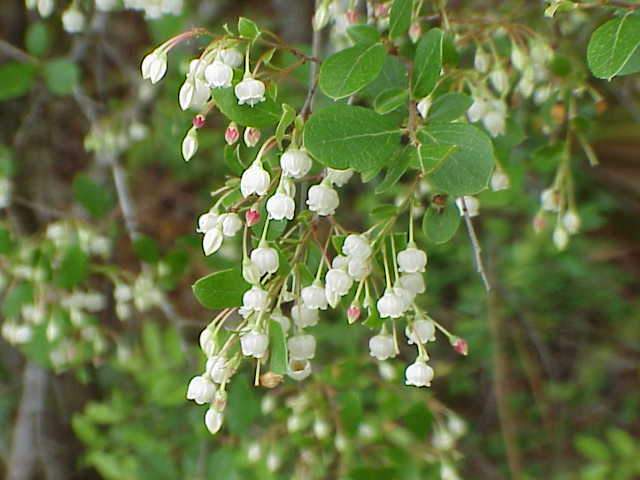
by Beth Bolles | Oct 17, 2024
UF IFAS Extension Escambia County was recently able to offer a native tree and shrub giveaway to our community. A county partner had some grant funding remaining and chose a nice selection of plants grown by a local native nursery. After seeing the plant selection, I was really excited that a few participating homeowners had the opportunity to take home one of my favorite native plants, the Sparkleberry, Vaccinium arboretum.
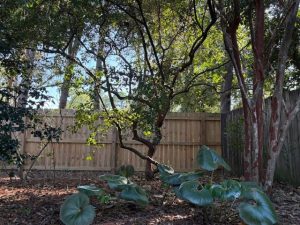
The Sparkleberry in the corner of my back yard. Photo by Beth Bolles, UF IFAS Extension Escambia County
Twenty-three years ago, I saved a sparkleberry on my new home lot because I loved this native tree. It has interest in all seasons in my opinion, including flowers, small fruit for wildlife, attractive bark, and an interesting shape as it matures. It has been a slower growing tree than others in my yard but I have enjoyed watching the tree develop its form and the bark develop the beautiful flaky cinnamon-brown look.
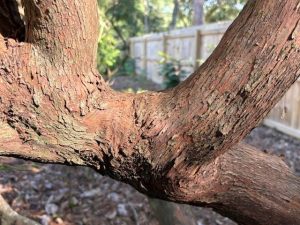
Sparkleberry bark and structure are attractive features in the landscape. Photo by Beth Bolles, UF IFAS Extension Escambia County.
The small tree is now about 12 feet tall and has never had any issues in the sandy, well drained soil. It can tolerate some moisture as long as the soil drains well. A grouping of trees from my neighbor’s lot keeps the plant in partial shade and we can often find sparkleberry specimens in the filtered light of woods. It can tolerate a sunnier location if that is the spot you have available for a small tree.
In addition to our enjoyment of this native tree, pollinators and other animals will appreciate the flower nectar, pollen, and berries. If you have a native nursery close to your home, be sure to ask for your own Sparkleberry if your site is suitable.
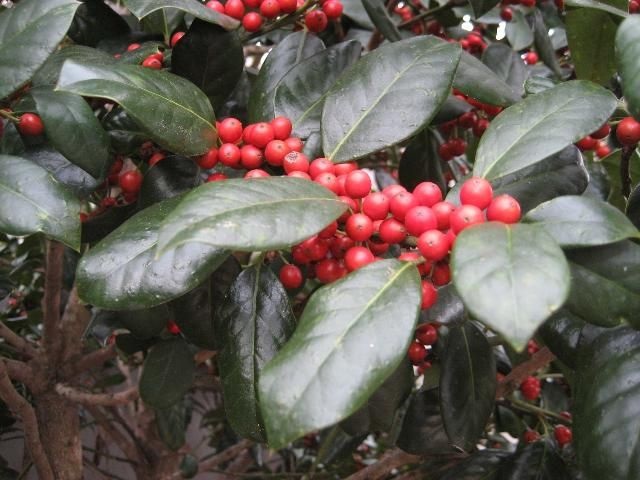
by Joshua Criss | Oct 4, 2024
Winter color is not always easy to find here in Florida. While staple annuals such as snapdragons (Antirrhinum majus) require planning and extra effort in the autumn. Instead, envision a perennial powerhouse that will not only provide colorful berries when the temperature drops but is a pollinator magnet in the spring. The Holly tree (Ilex spp.) perfectly embodies this vision. These low-maintenance evergreens, with their waxy leaves and colorful berries, are a sight to behold in your landscape, whether as a hedge or an accent plant.
Where and How to Plant
Hollies generally prefer partial shade and well-drained soils. However, exceptions exist, such as the Dahoon holly (Ilex cassine), adapted to wetter environments. Whatever cultivar you place in your landscape, following the planting and care instructions is crucial. Plant it in a hole approximately one foot wider than the root ball. Dig deep enough to cover most of the root ball but shallow enough so the uppermost root is slightly above the soil line. This may be counterintuitive, but roots need air to thrive, and shallow planting allows infiltration in the rhizosphere. To regulate soil temperature and soil moisture, add a 2-3 inch layer of mulch around the base of the plant. It is critical to leave some space between the tree trunk and mulch.
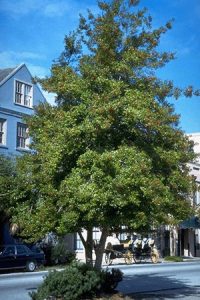
Photo: Edward Gilman, UF/IFAS.
Cultural Practices for Success
Irrigation is critical to establishing these plants, which should take between 3 and 6 months. Once established, cease irrigation except in drought conditions. Don’t apply too much water in either case, as hollies will suffer with wet feet. Fertilizers should be applied twice yearly in March and September. Have your soil tested before applying fertilizer to ensure a complete nutrient profile.
Pruning is not routinely required with holly trees. It is advisable to remove dead, diseased, and dysfunctional branches. Dysfunctional branches are those that grow back toward the main leader of the tree. These risk rubbing against one another, causing wounds that may become infiltration sites for pathogens. You should also remove sprouts coming from the root zone, commonly called suckers.
Potential Issues
Pests and pathogens are infrequent in hollies and are usually the product of improper growing practices. Occasionally, scale or spittlebug insects can infest the tree. Their presence will be punctuated by the appearance of blackened leaves, which is a symptom of sooty mold. Scouting these plants often will allow early detection and control of these pests. Some pathogens may also affect these trees. Most often, these are fungi caused by excessive moisture. Look for dieback or strange growth patterns in the plant’s foliage. When you see these, make sure the roots are not waterlogged.
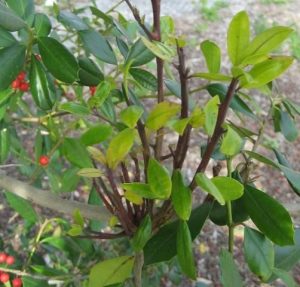
Photo: UF/IFAS
Summing Things Up
Hollies are an excellent and low maintenance addition to any landscape. Their berries and flowering patterns provide multiple seasons of interest and are a resource for birds and pollinators alike. For more information on Florida wildflowers, see these Ask IFAS documents, or contact your local extension agent for additional information on this and any topic regarding your gardens and more.
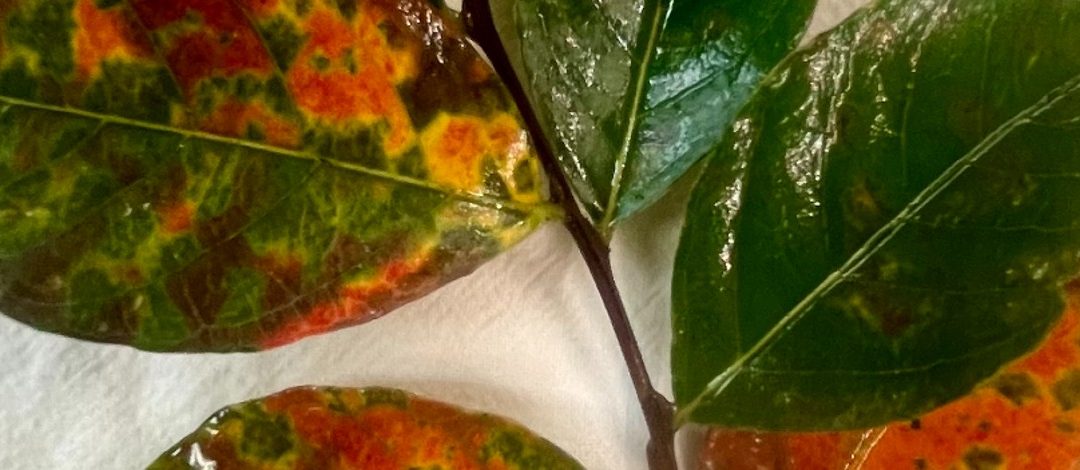
by Larry Williams | Sep 19, 2024
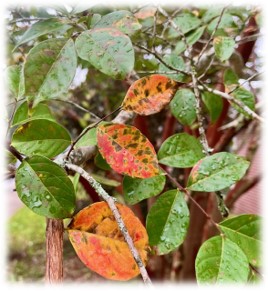
Normal fall leaves on deciduous crape myrtle. Credit: Larry Williams
Imagine you’re a leaf on a deciduous tree. In spring, you emerge and are blemish-free. You experience the first rays of light. You’ve never existed before. You begin to photosynthesize. This is what green leaves do. You’re normal.
The first windstorm occurs in April, blowing you into other leaves, branches and stems. You sustain a puncture wound. Trees don’t heal. So, any damage is permanent.
In May, a small population of aphids dine on the tree’s leaves. Ladybugs consume most of the aphids and a blowing rain dislodges the remaining few.
During the extended hot, dry weather of June and July, the tree’s owner is not watering properly and the tree begins dropping leaves. This is a normal process in many tree species during periods with insufficient moisture.
But you stay firmly attached.
The tree’s owner overdoes it in fertilizing his lawn and burns some of the tree’s leaves as a result. Most tree roots are shallow, having access to lawn fertilizer. Your leaf margin becomes brown and crisp as a result.
In August, you’re exposed to direct sunlight all day, partly because of the longer day length and partly because of the loss of other leaves that once shaded you.
In September, the tree’s owner applies weed and feed to his lawn. Tree roots growing in the lawn pull up some of the herbicide.
Tree roots grow two to three times beyond the branches, having access to herbicides applied to adjacent lawn areas. The herbicide injures many of the leaves, including you.
Shorter days and cooler temperatures of fall bring on changes in your physiology. The green pigment chlorophyll that has allowed you to produce sugars through photosynthesis since you first emerged is now breaking down.
As a result, your green color fades and fungal spots, sun scald and the puncture wound from spring become visible.
During October and November, many neighboring leaves turn loose and fall to the ground. This is part of the normal senescence process on deciduous trees.
Before you fall, the tree’s owner notices that you don’t look so good and becomes concerned about your brown spots instead of the uniform green color you had in spring. He has visions of another dead tree and rushes to his County Extension Office carrying you in hand.
A Master Gardener Volunteer explains to the tree’s owner that the spots are a natural part of the senescence process. The leaf is at the end of its life.
The tree’s owner is provided information on proper tree care.
The following spring, the tree produces new, healthy leaves, is provided better care and lives happily ever after!
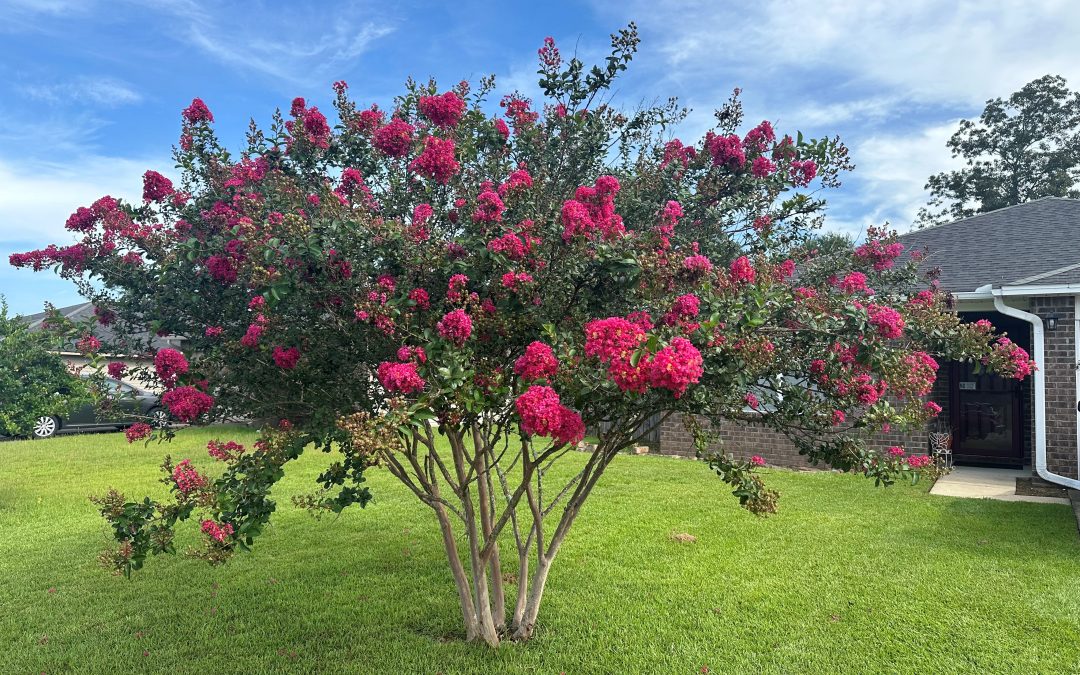
by Daniel J. Leonard | Aug 12, 2024
Despite being a near-perfect ornamental for the Panhandle, Crape Myrtle is often misused. Though there are dozens of commercially available varieties in all shapes and sizes, many people choose the wrong one for their yard. The most commonly sold cultivars ‘Natchez’ (white flowers), ‘Muskogee’ (pink flowers), and ‘Tuscarora’ (watermelon red flowers) – all three attain mature heights more than 20’ – are almost always too large for siting near a house or other structure and are often out of scale with landscapes. The simple solution to making the best use of Crape Myrtle in smaller yards (certainly not dramatic pruning – Crape Murder is among the worst landscape sins), is to select a smaller growing variety and ‘Tonto’ is a personal favorite in this category.
‘Tonto’ Crape Myrtle, one of the selections that emerged from Dr. Don Egolf’s Crape Myrtle breeding program at the U.S. National Arboretum over 50 years ago, is among my favorite Crape Myrtle varieties for several reasons. First, Tonto’s fuchsia hued flowers are as vibrant as flowers come; they practically glow in the landscape. The flower show lasts for several months and are a valuable food source for pollinators, bees in particular, in the late summer when few things are blooming. Tonto also is a relatively slow grower that only reaches about 10’ tall and wide at maturity. This allows the variety to be exceedingly versatile in landscapes as it can be used in the background of planting beds, as a specimen plant, limbed up as a small tree in open areas, or even placed in very large containers. Finally, beyond just the flower show and ideal size, ‘Tonto’ has uniquely attractive, cream colored, exfoliating bark and reliably attractive fall foliage. Both these features add interest to landscapes, even when ‘Tonto’ isn’t flowering.
Though ‘Tonto’ sports many unique qualities, it shares many other excellent traits and growing preferences with its Crape Myrtle kin. For best results growing any Crape Myrtle, trees should always be sited in full sun, at least 6-8 hours a day. Shading will result in greatly reduced flowering and lanky plants. Regular watering during the first year after planning while trees are becoming established is helpful, as is periodic fertilizer application. Once established, ‘Tonto’ and all other Crape Myrtles are exceedingly drought tolerant and can get by on their own with minimal inputs from gardeners.
If you’ve been struggling with a Crape Myrtle that has outgrown its site or thinking about planting a new Crape, I’d encourage you to give ‘Tonto’ a look. It’s an outstanding shrub/small tree, will reward you with flaming fuchsia flowers and smooth cream-colored bark each summer, and will never outgrow its space. Plant one today! For more information on growing Crape Myrtles or any other horticultural topic, contact us at the UF/IFAS Calhoun County Extension Office. Happy gardening.
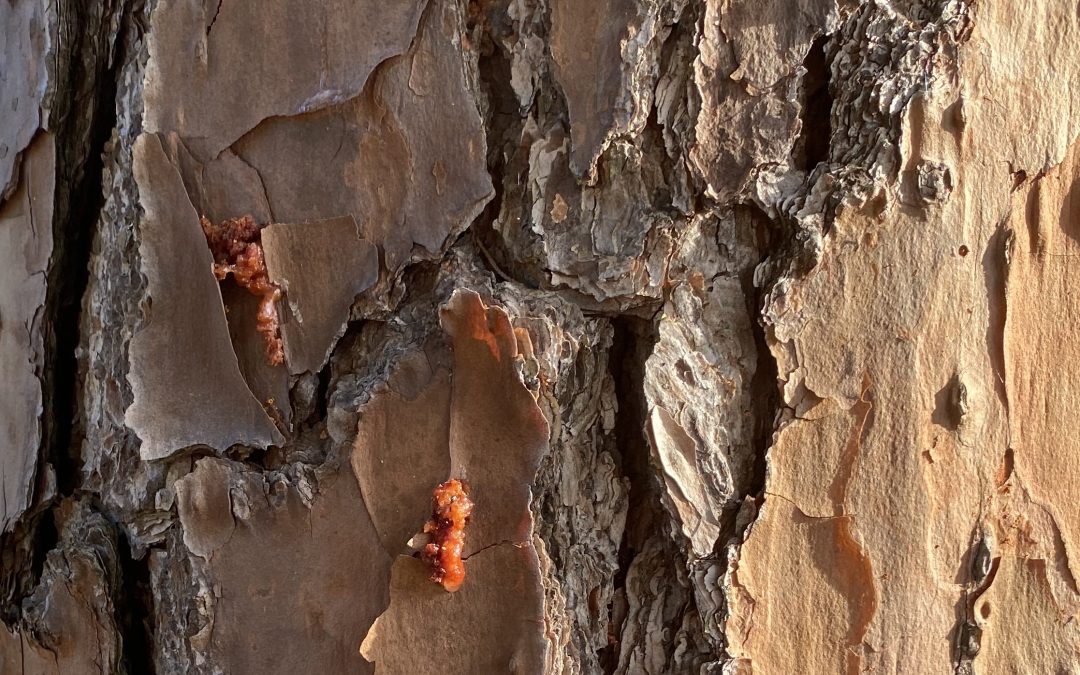
by Ian Stone | May 9, 2024
Pine Bark Beetles are an ever-present issue in both the urban and rural landscape across the Panhandle. If you have pines in your landscape you very well may experience issues with pine bark beetles. The tiny insects can decimate a pine rather quickly, and there are more than one type that can infest a tree. The Southern Pine Beetle is the bark beetle that most people are familiar with and most concerned about. In forestry settings the Southern Pine Beetle can have epidemic outbreaks that can devastate large areas of pine forests and plantation. While the Southern Pine Beetle is very destructive and a concern to forest health, there are other common pine bark beetles that often attack trees in our area. The two other common bark beetles are Ips pine engraver beetles and Black Turpentine Beetles. In urban settings these two beetles often are more common but they can easily wipe out several trees or more, which may pose a significant issue in the landscape.
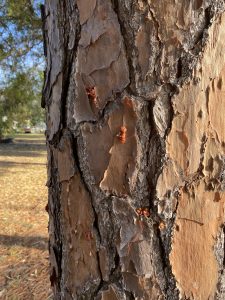
Resin pitches on bark that indicate pine bark beetle infestation. This shows a pine that is actively colonized by bark beetles and should be removed.
Photo Credit-Ian Stone
There are multiple species of Ips beetles and these tend to be a significant issue in landscapes, because they can easily wipe out most of the trees in a yard or park. They almost always target stressed or damaged trees, but they usually do not wipe out large areas like Southern Pine Beetle. Different Ips species will often attack different portions of the tree which can result in partial dieback of the crown or a slow yellowing and browning of the foliage. These beetles are very small, smaller than a grain of rice, and often are not seen readily without close inspection. Like other bark beetles the bark will often have resin oozing out and forming small pockets resembling popcorn. Other signs include yellowing and browning foliage and an accumulation of sawdust like material around the base. You may also see exit holes in the bark about the size of a pencil lead.
The Black Turpentine Beetle is closely related to the Southern Pine Beetle, but much larger and often attacks the lower portion of the tree. These beetles commonly attack older, damaged, and weakened trees. Historically they were often associated with turpentining operations and trees that had been worked for resin production, hence their common name. They are very attracted to trees that are damaged by equipment or that have had construction occur around them recently. The symptoms are generally the same as other pine bark beetles, but the resin pitches are larger and the exit holes are about the size of an eraser. While they are larger than other bark beetle they are still quite small by comparison to other insects, not much larger than a grain of rice and somewhat smaller than a pea.
If you notice pines in your area with bark beetle symptoms it is natural to be concerned. As the weather warms bark beetle activity increases and you may notice these symptoms on your pines. If you had bark beetles attack a tree in your yard last year you will want to keep an eye out for other pines being attacked in the spring. With the drought last year bark beetle activity increased and if the infected trees were not removed spots may reactivate in the spring and summer. Unfortunately, once bark beetles attack a pine there is really nothing to do other than removal. Insecticides and sprays will not do anything against bark beetles that are already in the tree. If you have high value pines in your landscape you want to preserve, prevention is key. First and foremost avoiding issues from equipment damage and construction is key as this will attract beetles. Preventative injections with systemic insecticides by a licensed professional can protect trees in your landscape. If you have noticed bark beetle activity in the area or have had to recently remove trees that died from bark beetles, consider preventative treatment to preserve trees that are at risk. Otherwise removing trees that become infested with bark beetles promptly is the best solution. Sometimes it can be difficult to determine what trees to remove, but any trees showing active bark beetle activity should be removed to prevent spread. Once bark beetles have colonized a tree and it is in decline preventative insecticide treatments are not going to be effective. You also don’t need to remove every pine in your landscape just because a single tree has bark beetles. At the following link you will find an IFAS EDIS article that is helpful in identifying bark beetles and making a decision about an infected tree https://edis.ifas.ufl.edu/publication/FR399.
If you see bark beetle activity on your property this spring contact your local IFAS extension office or your Florida Forest Service County Forester’s office for assistance and information. A Certified Arborist can assist you with determining how to remove infected trees or apply preventative treatments to trees at risk. With good decision making and management pine bark beetle attacks can be managed before they grow and spread. Now is a good time to keep an eye out and get ahead of any infestations that start.
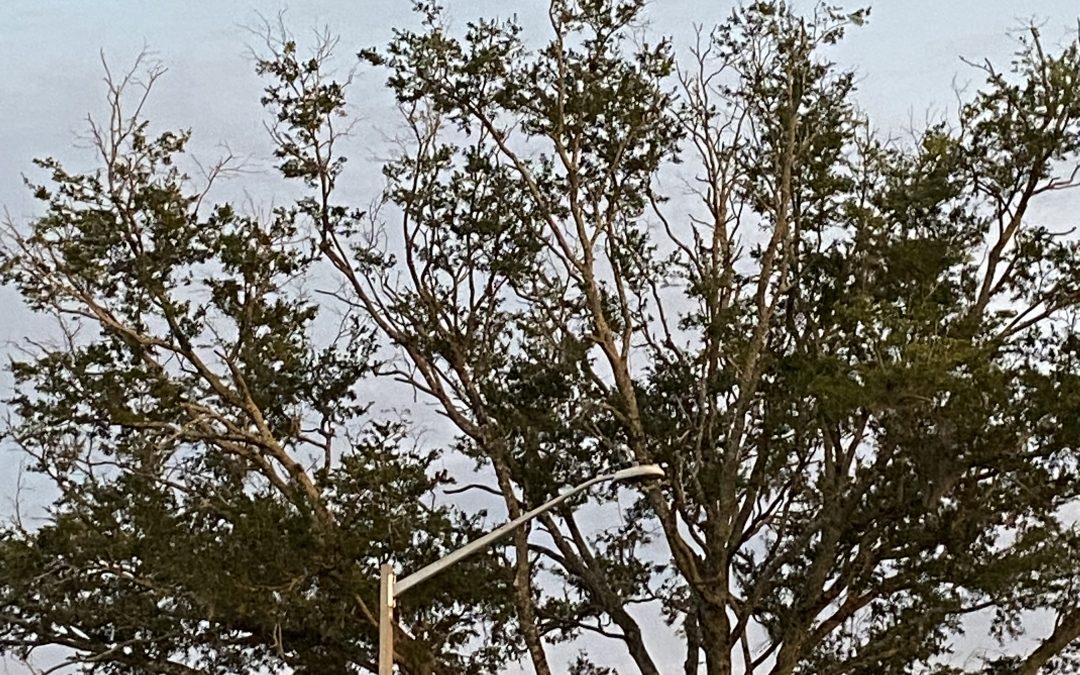
by Ian Stone | Mar 29, 2024
The crown of a tree is the leaf bearing twigs and branches and the spreading green foliage that we see. A heathy, full crown is a good indication of a healthy and vibrant tree. The crown and the foliage it supports is the energy collector and the center for photosynthesis, which is how the tree produces the energy it needs to live. For a tree to live and thrive, a full crown of leaves is essential, and an unhealthy and thin crown is an indicator the tree has issues. Crown dieback is often not noticed until it is relatively severe and at that point it can be too late. If a tree drops below a certain percentage of live crown it can no longer support itself and continues to decline. The good news is that if you notice your tree is starting to show signs of crown thinning and dieback you can likely intervene to improve its health or diagnose a problem early.
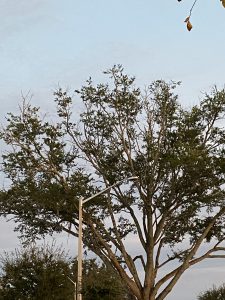
Tree Showing crown dieback, note the dead branches and lack of foliage on the outer branch tips.
Photo Credit-Ian Stone
Crown dieback, which is also referred to as crown decline, is a progressive issue that starts small and can progress to the point that only small sparse areas of foliage are left. It is a tree’s response to various stressors, including environmental conditions and severe rot/decay. As a response to severe stress, the tree begins to abort part of the leaves and some of the small branch tips. If the stress continues to worsen, the tree will continue to abort more of the crown, producing progressively more dead wood. The tree is essentially trying to prune itself back to a manageable level of foliage based on the stress it is encountering. This can occur in both small, young trees and mature, established trees. A variety of conditions cause the stress that begins this process. For instance, you may notice crown dieback in young trees planted in compacted urban conditions such as parking lots and paved areas. Trees in these conditions experience stress from the compacted soil and encounter subsequent issues with water and nutrient stress. Large mature trees in an area that experienced recent construction may also exhibit dieback, especially if buffers and setbacks are not maintained or significant fill dirt is brought in. Issues from root disturbance and compaction cause stress and root dieback, which in turn causes visible crown dieback. Additionally, trees that are experiencing rot, decay, and other vascular disease issues will often begin to exhibit dieback. As the rot or vascular disease progresses, the tree is less able to transport water to the crown, which results in the crown dieback that can be seen as the crown thins. Often, in cases of rot, crown dieback will be the primary visible symptom that rot is occurring, as the rot can be concealed deep in the tree. While multiple stressors can be the cause of crown dieback, it is a clear indicator a tree is stressed and in trouble. If this condition goes unnoticed, it can progress past the point that the tree can be saved. However, if noticed and caught early, good tree care techniques can be applied that may restore the tree to heath. In cases of severe rot and decay, having the tree examined may prevent structural failure of a tree exhibiting crown dieback.
If you have a tree on your property that is exhibiting crown dieback, it is a good idea to have the tree examined by a professional to determine the extent and nature of the issue. Key signs of dieback are bare branch tips and dying foliage during spring and summer. It is natural to have some dead wood in a tree, but extensive dead wood around the entire perimeter of the crown is a cause of concern. With good diagnosis, the proper tree care techniques can be applied to help a tree recover. Waiting and hoping a tree with crown dieback will recover on its own is not a good course of action. Recognizing crown dieback and taking early action is the key to success. Contacting a Certified Arborist (www.treesaregood.org ) is a good step in getting an opinion on the extent of dieback, if the tree is recoverable, and how to best address the issue. You can also contact your local County Extension Office or Florida Forest Service County Forester for assistance.













